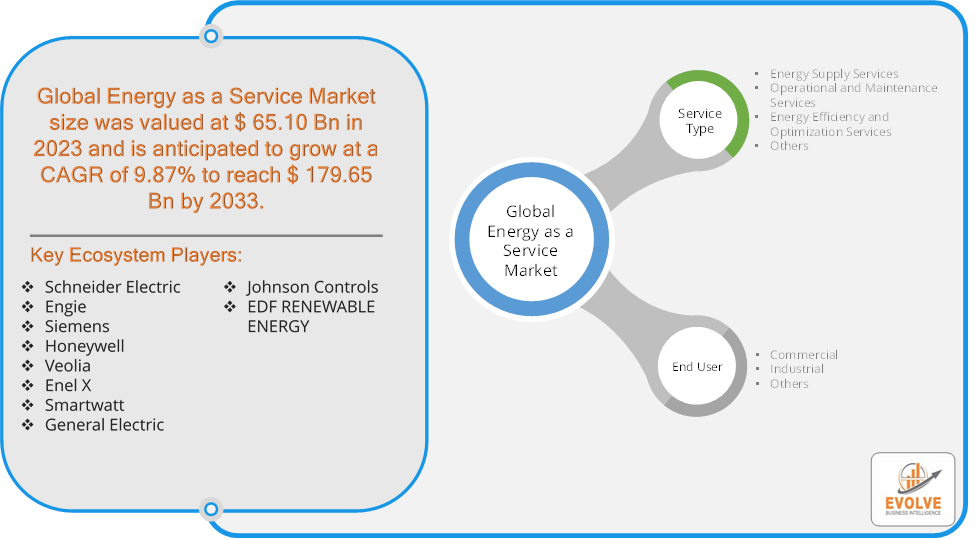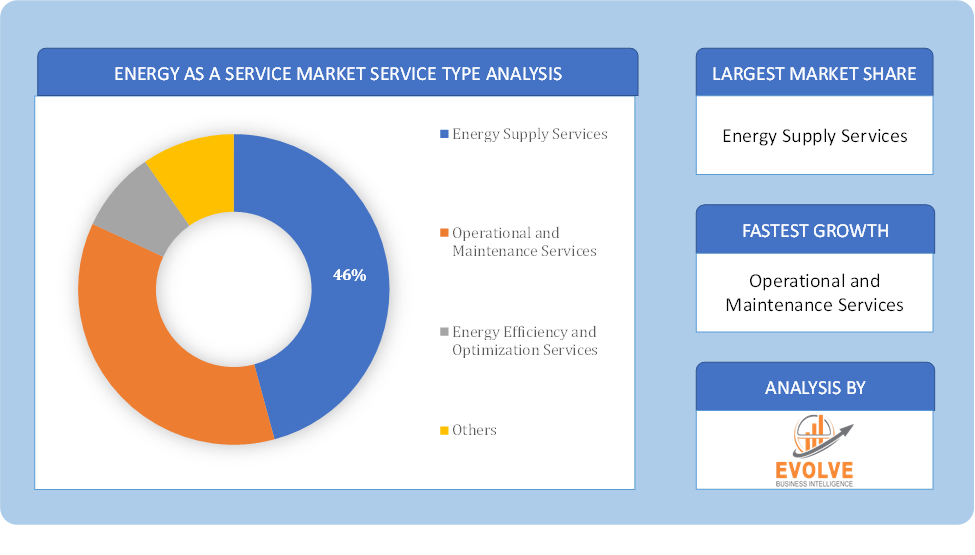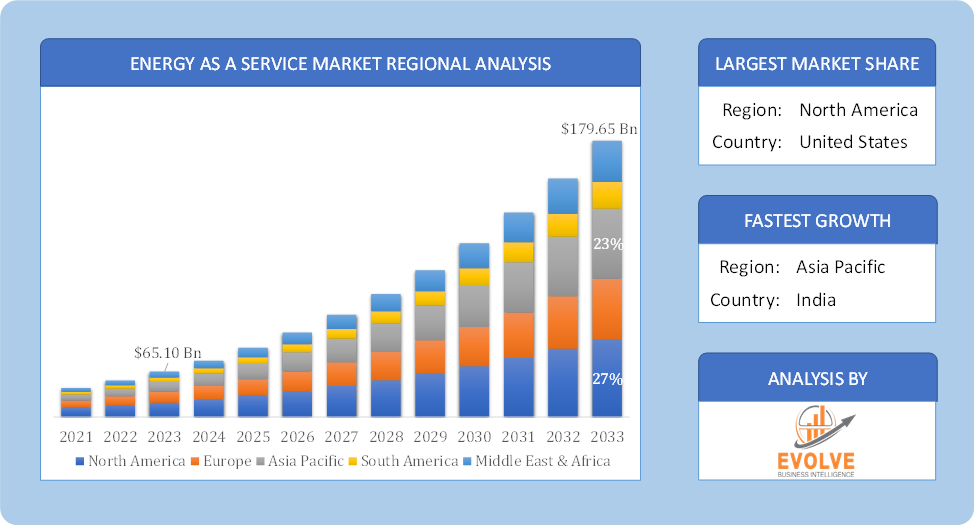Energy as a Service Market Analysis and Global Forecast 2023-2033
$ 1,390.00 – $ 5,520.00Price range: $ 1,390.00 through $ 5,520.00
Energy as a Service Market Research Report: Information By Service Type (Energy Supply Services, Operational and Maintenance Services, Energy Efficiency and Optimization Services, Others), By End-Users (Commercial, Industrial, Others), and by Region — Forecast till 2033
Page: 157
Energy as a Service Market Overview
The Energy as a Service Market Size is expected to reach USD 179.65 Billion by 2033. The Energy as a Service industry size accounted for USD 65.10 Billion in 2023 and is expected to expand at a compound annual growth rate (CAGR) of 9.87% from 2023 to 2033. Energy as a Service refers to food products that have been preserved through the process of freezing, wherein the food is subjected to extremely low temperatures, typically below 0 degrees Celsius (32 degrees Fahrenheit), to maintain its quality, nutritional value, and sensory attributes for an extended period. This preservation technique inhibits the growth of microorganisms and enzymatic activity, thereby slowing down the deterioration of the food. Energy as a Service encompasses a wide range of products, including raw ingredients, pre-cooked meals, snacks, desserts, and fully prepared dishes, which are typically packaged in airtight containers or bags to prevent freezer burn and maintain product integrity. The Energy as a Service industry is characterized by its convenience, extended shelf life, and diverse product offerings catering to consumer preferences and needs.
Global Energy as a Service Market Synopsis
 COVID-19 Impact Analysis
COVID-19 Impact Analysis
The COVID-19 pandemic has led to supply chain disruptions leading to supply shortages or lower demand in the Energy as a Service market. The travel restrictions and social-distancing measures have resulted in a sharp drop in consumer and business spending and this pattern is to continue for some time. The end-user trend and preferences have changed due to the pandemic and have resulted in manufacturers, developers, and service providers adopting various strategies to stabilize the company.
Energy as a Service Market Dynamics
The major factors that have impacted the growth of Energy as a Service are as follows:
Drivers:
Ø Technological Advancements
Rapid advancements in digital technologies, including IoT (Internet of Things), data analytics, and artificial intelligence, enhance the capabilities of EaaS solutions. These technologies enable real-time monitoring, predictive maintenance, and optimization of energy systems, thereby improving reliability and performance.
Restraint:
- Data Privacy and Security Concerns
The increased connectivity and data collection enabled by IoT and digital technologies in EaaS solutions raise concerns about data privacy and cybersecurity. Businesses may be reluctant to adopt EaaS due to fears of unauthorized access to sensitive operational data or disruptions in energy supply caused by cyber threats.
Opportunity:
⮚ Technological Innovation
Rapid advancements in digital technologies such as IoT, data analytics, and artificial intelligence are driving innovation within the EaaS market. These technologies enable real-time monitoring, predictive maintenance, and optimization of energy systems, enhancing reliability, performance, and energy efficiency. Integrating renewable energy sources and energy storage solutions further expands technological capabilities and supports sustainability goals.
Energy as a Service Segment Overview
 By Service Type
By Service Type
Based on Service Type, the market is segmented based on Energy Supply Services, Operational and Maintenance Services, Energy Efficiency and Optimization Services, Others. Energy Efficiency and Optimization Services typically dominate. These services focus on improving energy usage patterns, integrating renewable energy sources, and leveraging advanced technologies to enhance overall energy efficiency and sustainability for businesses and organizations.
By End User
Based on End Users, the market has been divided into the Commercial, Industrial, Others. the commercial sector tends to dominate. This includes office buildings, retail spaces, and hospitality venues, which benefit significantly from outsourced energy management to reduce costs and meet sustainability goals.
Global Energy as a Service Market Regional Analysis
Based on region, the global Energy as a Service market has been divided into North America, Europe, Asia-Pacific, the Middle East & Africa, and Latin America. North America is projected to dominate the use of the Energy as a Service market followed by the Asia-Pacific and Europe regions.
 Energy as a Service North America Market
Energy as a Service North America Market
North America holds a dominant position in the Energy as a Service Market. Due to the rapid advancements in data analytics and artificial intelligence (AI), the North American energy as a service market will control this one. Another factor driving the market’s growth in this region is the rising energy demand from both the industrial and residential sectors.
Energy as a Service Asia-Pacific Market
The Asia-Pacific region has indeed emerged as the fastest-growing market for the Energy as a Service industry. From 2023 through 2030, the energy as a service market in Asia-Pacific is anticipated to expand at the quickest rate. This is because there is effective grid infrastructure in place. Furthermore, the energy-as-service market in China had the most market share, while the market in India had the highest rate of growth in the Asia-Pacific area.
Competitive Landscape
The global Energy as a Service market is highly competitive, with numerous players offering a wide range of software solutions. The competitive landscape is characterized by the presence of established companies, as well as emerging startups and niche players. To increase their market position and attract a wide consumer base, the businesses are employing various strategies, such as product launches, and strategic alliances.
Prominent Players:
- Schneider Electric
- Engie
- Siemens
- Honeywell
- Veolia
- Enel X
- Smartwatt
- General Electric
- Johnson Controls
- EDF RENEWABLE ENERGY
Key Development
Besides, Schneider Electric announced GREENext is launching in December 2021. These two companies have united their forces for the purpose of providing energy-as-a-service to commercial and industrial customers through solar and battery hybrid microgrid technology.
Scope of the Report
Global Energy as a Service Market, by Service Type
- Energy Supply Services
- Operational and Maintenance Services
- Energy Efficiency and Optimization Services
- Others
Global Energy as a Service Market, by End User
- Commercial
- Industrial
- Others
Global Energy as a Service Market, by Region
- North America
- US
- Canada
- Mexico
- Europe
- UK
- Germany
- France
- Italy
- Spain
- Benelux
- Nordic
- Rest of Europe
- Asia Pacific
- China
- Japan
- South Korea
- Indonesia
- Austalia
- Malaysia
- India
- Rest of Asia Pacific
- South America
- Brazil
- Argentina
- Rest of South America
- Middle East & Africa
- Saudi Arabia
- UAE
- Egypt
- South Africa
- Rest of Middle East & Africa
| Parameters | Indicators |
|---|---|
| Market Size | 2033: USD 179.65 Billion |
| CAGR (2023-2033) | 9.87% |
| Base year | 2022 |
| Forecast Period | 2023-2033 |
| Historical Data | 2021 (2017 to 2020 On Demand) |
| Report Coverage | Revenue Forecast, Competitive Landscape, Growth Factors, and Trends |
| Key Segmentations | Service Type, End User |
| Geographies Covered | North America, Europe, Asia-Pacific, South America, Middle East, Africa |
| Key Vendors | Schneider Electric, Engie, Siemens, Honeywell, Veolia, Enel X, Smartwatt, General Electric, Johnson Controls, EDF RENEWABLE ENERGY. |
| Key Market Opportunities | · Increasing use of energy as a service (EASS) |
| Key Market Drivers | · Distributed energy sources Decarbonization of the global economy Manufacturers are shifting their focus on the use of sustainable energy |
REPORT CONTENT BRIEF:
- High-level analysis of the current and future Energy as a Service market trends and opportunities
- Detailed analysis of current market drivers, restraining factors, and opportunities in the future
- Energy as a Service market historical market size for the year 2021, and forecast from 2023 to 2033
- Energy as a Service market share analysis at each product level
- Competitor analysis with detailed insight into its product segment, Government & Defense strength, and strategies adopted.
- Identifies key strategies adopted including product launches and developments, mergers and acquisitions, joint ventures, collaborations, and partnerships as well as funding taken and investment done, among others.
- To identify and understand the various factors involved in the global Energy as a Service market affected by the pandemic
- To provide a detailed insight into the major companies operating in the market. The profiling will include the Government & Defense health of the company’s past 2-3 years with segmental and regional revenue breakup, product offering, recent developments, SWOT analysis, and key strategies.
Frequently Asked Questions (FAQ)
What is the study period of this market?
The study period of the global Energy as a Service market is 2021- 2033
What is the growth rate of the global Energy as a Service market?
The global Energy as a Service market is growing at a CAGR of 9.87% over the next 10 years
Which region has the highest growth rate in the market of Energy as a Service?
Asia Pacific is expected to register the highest CAGR during 2023-2033
Which region has the largest share of the global Energy as a Service market?
North America holds the largest share in 2022
Who are the key players in the global Energy as a Service market?
Schneider Electric, Engie, Siemens, Honeywell, Veolia, Enel X, Smartwatt, General Electric, Johnson Controls, and EDF RENEWABLE ENERGY are the major companies operating in the market.
Do you offer Post Sale Support?
Yes, we offer 16 hours of analyst support to solve the queries
Do you sell particular sections of a report?
Yes, we provide regional as well as country-level reports. Other than this we also provide a sectional report. Please get in contact with our sales representatives.
Press Release

Global Pharmaceutical Manufacturing Market to Reach $1.38 Trillion by 2035 with 7.35% CAGR, New Research Shows

The Global Mammography Market Is Estimated To Record a CAGR of Around 10.29% During The Forecast Period

Glue Stick Market to Reach USD 2.35 Billion by 2034

Podiatry Service Market to Reach USD 11.88 Billion by 2034

Microfluidics Technology Market to Reach USD 32.58 Billion by 2034

Ferric Chloride Market to Reach USD 10.65 Billion by 2034

Family Practice EMR Software Market to Reach USD 21.52 Billion by 2034

Electric Hairbrush Market to Reach USD 15.95 Billion by 2034

Daily Bamboo Products Market to Reach USD 143.52 Billion by 2034

Cross-border E-commerce Logistics Market to Reach USD 112.65 Billion by 2034
Table of Content
Chapter 1. Executive Summary Chapter 2. Scope Of The Study 2.1. Market Definition 2.2. Scope Of The Study 2.2.1. Objectives of Report 2.2.2. Limitations 2.3. Market Structure Chapter 3. Evolve BI Methodology Chapter 4. Market Insights and Trends 4.1. Supply/ Value Chain Analysis 4.1.1. Raw End Users Providers 4.1.2. Manufacturing Process 4.1.3. Distributors/Retailers 4.1.4. End-Use Industry 4.2. Porter’s Five Forces Analysis 4.2.1. Threat Of New Entrants 4.2.2. Bargaining Power Of Buyers 4.2.3. Bargaining Power Of Suppliers 4.2.4. Threat Of Substitutes 4.2.5. Industry Rivalry 4.3. Impact Of COVID-19 on the Energy as a Service Market 4.3.1. Impact on Market Size 4.3.2. End-Use Industry Trend, Preferences, and Budget Impact 4.3.3. Regulatory Framework/Government Policies 4.3.4. Key Players' Strategy to Tackle Negative Impact 4.3.5. Opportunity Window 4.4. Technology Overview 12.28. Macro factor 4.6. Micro Factor 4.7. Demand Supply Gap Analysis of the Energy as a Service Market 4.8. Import Analysis of the Energy as a Service Market 4.9. Export Analysis of the Energy as a Service Market Chapter 5. Market Dynamics 5.1. Introduction 5.2. DROC Analysis 5.2.1. Drivers 5.2.2. Restraints 5.2.3. Opportunities 5.2.4. Challenges 5.3. Patent Analysis 5.4. Industry Roadmap 5.5. Parent/Peer Market Analysis Chapter 6. Global Energy as a Service Market, By Service Type 6.1. Introduction 6.2. Energy Supply Services 6.3. Operational and Maintenance Services 6.4. Energy Efficiency and Optimization Services 6.5. Others Chapter 7. Global Energy as a Service Market, By End User 7.1. Introduction 7.2. Commercial 7.3. Industrial 7.4. Others Chapter 8. Global Energy as a Service Market, By Region 8.1. Introduction 8.2. North America 8.2.1. Introduction 8.2.2. Driving Factors, Opportunity Analyzed, and Key Trends 8.2.3. Market Size and Forecast, By Country, 2023-2033 8.2.4. Market Size and Forecast, By Service Type, 2023-2033 8.2.5. Market Size and Forecast, By End User, 2023-2033 8.2.6. US 8.2.6.1. Introduction 8.2.6.2. Driving Factors, Opportunity Analyzed, and Key Trends 8.2.6.3. Market Size and Forecast, By Service Type, 2023-2033 8.2.6.4. Market Size and Forecast, By End User, 2023-2033 8.2.7. Canada 8.2.7.1. Introduction 8.2.7.2. Driving Factors, Opportunity Analyzed, and Key Trends 8.2.7.4. Market Size and Forecast, By Service Type, 2023-2033 8.2.7.5. Market Size and Forecast, By End User, 2023-2033 8.3. Europe 8.3.1. Introduction 8.3.2. Driving Factors, Opportunity Analyzed, and Key Trends 8.3.3. Market Size and Forecast, By Country, 2023-2033 8.3.4. Market Size and Forecast, By Service Type, 2023-2033 8.3.5. Market Size and Forecast, By End User, 2023-2033 8.3.6. Germany 8.3.6.1. Introduction 8.3.6.2. Driving Factors, Opportunity Analyzed, and Key Trends 8.3.6.3. Market Size and Forecast, By Service Type, 2023-2033 8.3.6.4. Market Size and Forecast, By End User, 2023-2033 8.3.7. France 8.3.7.1. Introduction 8.3.7.2. Driving Factors, Opportunity Analyzed, and Key Trends 8.3.7.3. Market Size and Forecast, By Service Type, 2023-2033 8.3.7.4. Market Size and Forecast, By End User, 2023-2033 8.3.8. UK 8.3.8.1. Introduction 8.3.8.2. Driving Factors, Opportunity Analyzed, and Key Trends 8.3.8.3. Market Size and Forecast, By Service Type, 2023-2033 8.3.8.4. Market Size and Forecast, By End User, 2023-2033 8.3.9. Italy 8.3.9.1. Introduction 8.3.9.2. Driving Factors, Opportunity Analyzed, and Key Trends 8.3.9.3. Market Size and Forecast, By Service Type, 2023-2033 8.3.9.4. Market Size and Forecast, By End User, 2023-2033 8.3.11. Rest Of Europe 8.3.11.1. Introduction 8.3.11.2. Driving Factors, Opportunity Analyzed, and Key Trends 8.3.11.3. Market Size and Forecast, By Service Type, 2023-2033 8.3.11.4. Market Size and Forecast, By End User, 2023-2033 8.4. Asia-Pacific 8.4.1. Introduction 8.4.2. Driving Factors, Opportunity Analyzed, and Key Trends 8.4.3. Market Size and Forecast, By Country, 2023-2033 8.4.4. Market Size and Forecast, By Service Type, 2023-2033 8.12.28. Market Size and Forecast, By End User, 2023-2033 8.4.6. China 8.4.6.1. Introduction 8.4.6.2. Driving Factors, Opportunity Analyzed, and Key Trends 8.4.6.3. Market Size and Forecast, By Service Type, 2023-2033 8.4.6.4. Market Size and Forecast, By End User, 2023-2033 8.4.7. India 8.4.7.1. Introduction 8.4.7.2. Driving Factors, Opportunity Analyzed, and Key Trends 8.4.7.3. Market Size and Forecast, By Service Type, 2023-2033 8.4.7.4. Market Size and Forecast, By End User, 2023-2033 8.4.8. Japan 8.4.8.1. Introduction 8.4.8.2. Driving Factors, Opportunity Analyzed, and Key Trends 8.4.8.3. Market Size and Forecast, By Service Type, 2023-2033 8.4.8.4. Market Size and Forecast, By End User, 2023-2033 8.4.9. South Korea 8.4.9.1. Introduction 8.4.9.2. Driving Factors, Opportunity Analyzed, and Key Trends 8.4.9.3. Market Size and Forecast, By Service Type, 2023-2033 8.4.9.4. Market Size and Forecast, By End User, 2023-2033 8.4.10. Rest Of Asia-Pacific 8.4.10.1. Introduction 8.4.10.2. Driving Factors, Opportunity Analyzed, and Key Trends 8.4.10.3. Market Size and Forecast, By Service Type, 2023-2033 8.4.10.4. Market Size and Forecast, By End User, 2023-2033 8.5. Rest Of The World (RoW) 8.5.1. Introduction 8.5.2. Driving Factors, Opportunity Analyzed, and Key Trends 8.5.3. Market Size and Forecast, By Service Type, 2023-2033 8.5.4. Market Size and Forecast, By End User, 2023-2033 Chapter 9. Company Landscape 9.1. Introduction 9.2. Vendor Share Analysis 9.3. Key Development Analysis 9.4. Competitor Dashboard Chapter 10. Company Profiles 10.1. Schneider Electric 10.1.1. Business Overview 10.1.2. Government & Defense Analysis 10.1.2.1. Government & Defense – Existing/Funding 10.1.3. Product Portfolio 10.1.4. Recent Development and Strategies Adopted 10.1.5. SWOT Analysis 10.2. Engie 10.2.1. Business Overview 10.2.2. Government & Defense Analysis 10.2.2.1. Government & Defense – Existing/Funding 10.2.3. Product Portfolio 10.2.4. Recent Development and Strategies Adopted 10.2.5. SWOT Analysis 10.3. Siemens 10.3.1. Business Overview 10.3.2. Government & Defense Analysis 10.3.2.1. Government & Defense – Existing/Funding 10.3.3. Product Portfolio 10.3.4. Recent Development and Strategies Adopted 10.3.5. SWOT Analysis 10.4. Honeywell 10.4.1. Business Overview 10.4.2. Government & Defense Analysis 10.4.2.1. Government & Defense – Existing/Funding 10.4.3. Product Portfolio 10.4.4. Recent Development and Strategies Adopted 10.12.28. SWOT Analysis 10.5. Veolia 10.5.1. Business Overview 10.5.2. Government & Defense Analysis 10.5.2.1. Government & Defense – Existing/Funding 10.5.3. Product Portfolio 10.5.4. Recent Development and Strategies Adopted 10.5.5. SWOT Analysis 10.6. Enel X 10.6.1. Business Overview 10.6.2. Government & Defense Analysis 10.6.2.1. Government & Defense – Existing/Funding 10.6.3. Product Portfolio 10.6.4. Recent Development and Strategies Adopted 10.6.5. SWOT Analysis 10.7. Smartwatt 10.7.1. Business Overview 10.7.2. Government & Defense Analysis 10.7.2.1. Government & Defense – Existing/Funding 10.7.3. Product Portfolio 10.7.4. Recent Development and Strategies Adopted 10.7.5. SWOT Analysis 10.8 General Electric 10.8.1. Business Overview 10.8.2. Government & Defense Analysis 10.8.2.1. Government & Defense – Existing/Funding 10.8.3. Product Portfolio 10.8.4. Recent Development and Strategies Adopted 10.8.5. SWOT Analysis 10.9 Johnson Controls 10.9.1. Business Overview 10.9.2. Government & Defense Analysis 10.9.2.1. Government & Defense – Existing/Funding 10.9.3. Product Portfolio 10.9.4. Recent Development and Strategies Adopted 10.9.5. SWOT Analysis 10.10. EDF RENEWABLE ENERGY 10.10.1. Business Overview 10.10.2. Government & Defense Analysis 10.10.2.1. Government & Defense – Existing/Funding 10.10.3. Product Portfolio 10.10.4. Recent Development and Strategies Adopted 10.10.5. SWOT Analysis
Connect to Analyst
Research Methodology



 Energy as a Service North America Market
Energy as a Service North America Market

